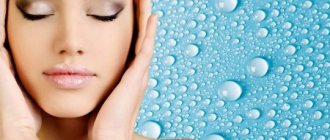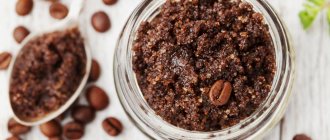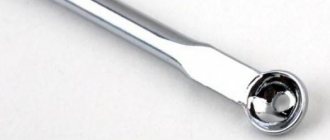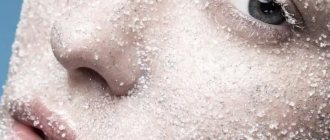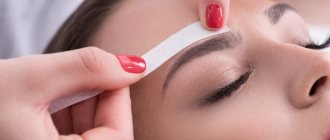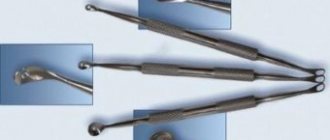Why do you need to prepare for facial peeling?
Do I need to prepare my facial skin for peeling? Or is it acceptable to apply an exfoliant directly to the surface of the skin and wait for the results?
Conducting pre-peeling preparation is undoubtedly necessary, if not necessary. The procedure of preparing the face for peeling, carried out in the salon or at home, helps to achieve the following effects:
- Align and loosen the layers of the epidermis. Thanks to this, the acidic composition of the exfoliant will be distributed evenly over the surface of the skin.
- Minimize the risk of post-peeling side effects and complications. These include acne, age spots, erythema, etc.
- Activate the protective functions of the skin and its ability to regenerate.
Thus, preparing for facial peeling is not a whim, but a real necessity, making the process of subsequent exfoliation better and more effective.
What types exist
Medium peels come in different types. In modern cosmetology there are chemical and hardware peels. For example, one of the new products is fractional laser thermolysis - treatment of the skin with laser beams. Diamond dermabrasion is also becoming popular. Both methods are based on the principle of cell absorption: as a result of treating the skin with rays (diamond dust), microexplosions occur inside the dermis, and the tissues literally evaporate.
The technology is excellent, but, unfortunately, it is not yet available to the general public. Chemical peels are another matter - many people can afford them today.
Medium chemical peeling involves influencing the dermis with special compounds, which always contain concentrated acids with a strength of 25-30%.
Most popular:
- fruity;
- glycolic;
- trichloroacetic;
- salicylic.
The disadvantage of using these acids is the difficulty of correctly calculating the depth of penetration of the substances into the skin, which is dangerous due to burns. That is why retinoic peeling (acid made from retinol, that is, vitamin A) and TCA technology are often used today. It uses a soft gel that slowly penetrates all layers of the epithelium. They are easier to track, which reduces the risk of damage to a minimum.
Who will benefit from the procedure? Medium peeling is prescribed for skin rejuvenation. This comes first. But there are also purely medical indications for quality facial care - age spots, warts, stretch marks, acne marks and even some types of scars. After deep cleansing of the skin, they become invisible and often simply disappear from the surface of the dermis.
How to prepare your skin for peeling?
How to prepare your skin for peeling? The features of this process depend on the immediate location of exfoliation. Home and salon procedures differ both in the method of implementation and in the subtleties of preparation for peeling.
At home
The best preparation in this case is to remove make-up from your face, removing dust, dirt and sebum residues. If peeling takes place at home, special tonics, foams or cleansing milk suitable for your skin type are suitable for this purpose.
Only after completely degreasing the skin before peeling at home can you apply an exfoliant.
It would seem that everything is simple and extremely clear. Yes, but only exclusively for the day of peeling. But full preparation for peeling must begin approximately 3-4 weeks before the procedure.
This process includes the following steps:
- Applying cream to prepare for peeling. These products contain fruit acids, which have a mild effect on the epidermis. They also eliminate all irregularities in the stratum corneum of the skin.
- Distribution of sunscreens over the skin. They protect the skin from the harmful effects of the sun, preparing it for peeling.
- Additionally, medications with pronounced antiviral activity may be prescribed. This eliminates the risk of developing post-peeling herpes infection.
It is better to discuss the selection of such medications with your doctor. By the way. 3-4 weeks is the conditional period for preparing the skin for peeling. If daily care included acidic products, pre-peeling preparation may take much less time. In this case, a composition with a small concentration of acids (glycolic, kojic, phytic, ascorbic, etc.) is applied to the skin.
The use of pre-peeling agents helps to properly deplete the skin, as a result of which the active peeling acids act on the epidermis much more effectively. It is necessary to stop using products containing aha acids a couple of days before the intended exfoliation. By properly preparing for peeling, you have a chance to get wonderful results in a short period of time.
Important. The main condition is to stop all manipulations that could cause damage to the skin (scrub, cleansing, depilation, etc.) 7 days before peeling (regardless of its type).
In the cabin
Preparing for a chemical peeling procedure in a beauty salon is considered a more thorough procedure than doing it at home. The main emphasis here is the examination by a cosmetologist. . A professional must certainly determine the type of skin, the characteristics of its aging, take into account the presence or absence of inflammatory processes or pigmentation, and identify the degree of elasticity and skin tightness.
The next stage is collecting the patient’s medical history. The cosmetologist must have an idea of the client’s health status. Thus, we can conclude about the presence or absence of contraindications to the peeling procedure. For example, if a client frequently experiences herpes flare-ups, the professional should initially recommend antiviral treatment and then proceed with the peeling procedure.
- List of sample questions that a cosmetologist should ask a client:
- Are tobacco products used?
- Are there any allergies to any substances?
- What medications are currently used?
- Have you had plastic surgery or x-rays in your recent past?
- What beauty products have been your mainstay at home for the past few months?
Also, the cosmetologist must monitor the condition of the patient’s capillaries, because skin regeneration processes depend on the characteristics of microcirculation. If weak blood vessels are the result of a lack of fatty acids or micronutrients, the client should begin taking a multivitamin complex.
We suggest you watch the video to see how the procedure is performed by a cosmetologist:
Additionally, a specialist may recommend doing 1-2 trial sessions of mesotherapy or biorevitalization. Such procedures are carried out in preparation for medium peeling 2-4 weeks before it. In addition to these procedures, ultrasonic facial cleansing may be prescribed.
Advice. Most cosmetic brands that produce exfoliation products additionally require pre-peeling preparations. You should not neglect the offer of a cosmetologist who offers to use such a product, although the price of the procedure may increase after using it. This use of professional products is not about pumping money out of the client, but about full compliance with all the rules for exfoliation. For example, the pre-peeling preparation of a glycolic exfoliant must certainly include such preliminary agents. This will make the procedure safe and effective.
Operating principle and effectiveness
Medium peeling is one of the types of peelings that have recently entered the lives of many women, becoming a universal and affordable method of rejuvenating the dermis. The word peeling comes from the English “to peel”, which translates as cleansing, scraping. This translation gives an excellent idea of the essence of the methodology itself. It is based on external cleansing of the facial skin through the use of external irritants.
Curious! Human skin consists of several layers. During their life, they become rough and clogged with dead cells. Sometimes the skin begins to resemble a “sole”, and peelings combat this unpleasant phenomenon, restoring youthful freshness to the face.
This can be fruit acid, special compositions where a good balance of substances with a whitening effect is selected. There are also serious methods, such as nanoperforation of the skin: first it is treated with gels, and then with laser beams, flashes of intense light, and so on. Essentially, the cosmetologist aims to burn the top layer of skin. To give way to new young dermis hidden under several layers of skin that has deteriorated over the years.
In the practice of modern cosmetologists, light superficial and medium peels are used. There are also serious medical measures that affect the deeper layers of the skin. They can only be done by a professional dermatologist, and rehabilitation requires a hospital stay.
Medium facial peels are optimal. They are moderately delicate and perfectly renew the skin: if everything was done correctly, the results are amazing and beautiful. The woman is transformed and begins to glow from within. The procedure is especially effective for women over 35 years of age. For younger ladies, superficial cleansing manipulations are recommended.
What can be achieved with the procedure:
- pleasant velvety skin texture;
- significant improvement in skin texture;
- a noticeable reduction in the number of wrinkles on the face (according to the most rough estimates, their number is reduced to 30-40%, that is, almost half);
- disappearance of deep facial wrinkles on the forehead, near the mouth;
- destruction of defects - scars, dimples after acne, tiny potholes after smallpox;
- a rejuvenation effect that catches the eye of friends and colleagues.
In the process, the production of collagen and elastin is launched: they help the dermis to remain firm, elastic, and young. As a result, after the procedure, the complexion becomes fresh. It seems as if she is shining from the inside. Due to the general equalization of tone, improvement of relief and increase in elasticity, a clear feeling of lifting is created, comparable even to a tightening.
However, there is one factor to consider. The fact is that medium peels, in particular retinoic peels, have a powerful exfoliating effect. So you’ll have to wait out this slight inconvenience for a few days while the old skin peels off.
Recommendations from cosmetologists
The most important recommendations from a cosmetologist:
- Regardless of whether facial exfoliation will be done in the salon or at home, in the process of preparing for it you should take into account the advice of a cosmetologist on preparing for peeling:
- A week before the intended procedure, you should limit your visits to saunas, steam rooms, baths and swimming pools.
- For 2 weeks before exfoliation, you should not expose your skin to tanning or visit a solarium.
- For 7 days prior to peeling, sunscreen lotions or creams with a high level of protection (at least 35) should be applied to the face.
- Before manipulation, it is necessary to eliminate all inflammation, pimples, acne, and get rid of dermatological diseases.
- All herpetic rashes, for example, in the lip area, should be eliminated not only with ointments, but also with antiviral drugs.
- Avoid using any products containing abrasive particles (for example, coffee-based, salt, sugar, etc.). The same applies to gommages and other exfoliating products based on fruit or salicylic acids.
- If the purpose of exfoliation is to eliminate pigmentation, a week before the procedure you should start using whitening products (lotions, creams based on kojic or azelaic acid). They slow down the formation of melanocytes.
Possible contraindications
Medium chemical peeling is a universal procedure that has quite a few contraindications. It can be done for women and men suffering from noticeable age-related changes. But still, in a number of cases, it may be prohibited.
Reasons for refusal:
- the presence of any neoplasms of unknown nature on the skin;
- pathologies of the cardiovascular system;
- chronic disorders of the kidneys and liver;
- inflammatory processes on the skin, purulent lesions;
- tendency to form scars;
- blood diseases;
- clotting disorder;
- epilepsy;
- mental disorders;
- diabetes;
- taking antibiotics from the tetracycline group.
To avoid adverse reactions, medium peels are not performed on pregnant and lactating women. Also, an obstacle is individual intolerance to individual components of the mid-peel and a tendency to allergic reactions. Before starting the procedure, the cosmetologist finds out the medical history, collects information about lifestyle, the presence of chronic diseases, in order to select the most correct dosage of the cleansing composition.
Rehabilitation rules
Rehabilitation after a mid-peel does not last that long and takes about 10 days in total (from the moment of the first procedure). You should be prepared for the fact that on the third or fourth day the face actively peels off, crusts appear, pieces of skin come off by themselves, like an old lizard skin.
What not to do during the recovery period:
- scratch your face;
- peel off the crusts;
- use foundation (in general it is better not to apply decorative cosmetics);
- visit baths, solariums, swimming pools where the water can be chlorinated;
- use active anti-aging creams with whitening components;
- going out into strong winds, severe frost;
- smoke, drink alcohol.
Cosmetologists recommend spending the first days after the procedure at home and lubricating your face with depanthenol more often: this way the skin will recover much faster. But, if you put in the effort and listened to the cosmetologist’s recommendations, the result will please you. The effect of medium peeling lasts up to two years.
Patient reviews
There are different reviews about medium peeling. In most cases, patients see positive changes and are satisfied with the results. Sometimes the picture is clouded by complications.
The patient suffered complications.
I like the result of the treatment.
The patient sees an improvement in the picture, but the problem is not completely solved.
The patient sees the positive effect of exfoliation.
Basic Process Steps
The session proceeds in the following steps:
- Step 1. Examination by a cosmetologist and identification of readiness for the procedure.
- Step 2. Cleansing the affected area from grease, dust, and cosmetic residues.
- Step 3. Protect your eyes and lips from the effects of the peeling mixture.
- Step 3. Depending on the type, the face is cleaned using a medium peeling method. If peeling is carried out chemically, then an acidic composition is applied and after the appearance of a white coating, the acidic mixture is neutralized.
- Step 4. A protective, nourishing, anti-inflammatory and moisturizing mask is made.
Medium peeling stages
Session price
Medium peeling is considered a middle class procedure. There are cosmetic clinics where one procedure costs 5,000 rubles. Privately, you can find a more affordable price - from 2000 per session. But here it is important to completely trust the master, to be confident in the quality of the materials with which he carries out the cleansing.
Professional opinion
I. Dorofeeva, cosmetologist
“Most peeling methods can be quite dangerous, sometimes leaving the skin feeling like paper thin. To prevent the situation from getting worse, you should contact an experienced specialist. For the first time, you should still think carefully and choose a less aggressive peeling procedure. Medium peeling should be neglected for now. Besides this, there are other very effective procedures that may be enough to achieve results.”
Not all doctors have a positive attitude towards this procedure


